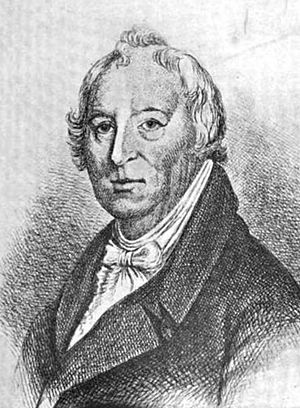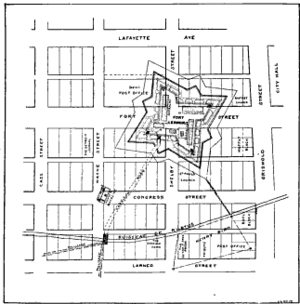Fort Shelby (Michigan) facts for kids
Quick facts for kids Fort Shelby (Fort Lernoult, Fort Detroit) |
|
|---|---|
| Detroit, Michigan | |
| Type | Fort |
| Site information | |
| Controlled by | British (1779-1796) Americans (1796-1812) British (1812-1813) Americans (1813-1826) |
| Site history | |
| Built | 1778–1779 |
| Built by | British |
| In use | 1779–1826 |
| Materials | Wood, earth |
| Demolished | 1827 |
| Garrison information | |
| Past commanders |
Richard B. Lernoult, Jean François Hamtramck, William Hull |
Fort Shelby was an important military fort in Detroit, Michigan. It played a big role in the War of 1812. The British built it in 1779 and called it Fort Lernoult.
In 1796, the fort was given to the United States because of the Jay Treaty. In 1805, it was renamed Fort Detroit by Secretary of War Henry Dearborn. The American commander William Hull surrendered the fort in 1812 during the War of 1812. However, the U.S. took it back in 1813. The Americans then renamed it Fort Shelby. The fort was given to the city of Detroit in 1826 and taken down in 1827.
Contents
History of Fort Shelby
How the British Built Fort Lernoult
In 1778, Captain Richard Lernoult was the British Army commander at Fort Detroit. He worried that the old fort was not strong enough. American forces, led by Colonel Daniel Brodhead, were getting close.
Captain Lernoult sent Captain Henry Bird to find a better spot for a new fort. They started building in November 1778. The weather was very bad, but by October 1779, 381 British soldiers were at the new fort.
The fort was built with a base of tree trunks, about 4 feet high. On top of these were sharpened stakes, 7 to 8 feet long. All of this was covered with an earth wall, 11 feet high. This wall was 12 feet wide at the top and 26 feet thick at the bottom. Outside the wall was a deep ditch, 5 to 6 feet deep and 12 feet wide. This ditch also had a wooden picket fence, 11 to 12 feet tall.
When America Took Control
After the American Revolutionary War ended in 1783, the British promised to leave their forts in U.S. land. But they kept six forts, including Fort Lernoult. These forts were Fort Oswegatchie, Fort Niagara, Fort Ontario, Fort Miami (Ohio), and Fort Mackinac.
In 1794, President George Washington sent John Jay to London to solve this problem. The Jay Treaty said the forts must be given to the U.S. by June 1796. The British left Fort Lernoult and moved to Fort Amherstburg in Canada. On July 11, 1796, Americans took over the fort. Colonel Jean François Hamtramck led 300 men into the fort.
Fort Detroit and the War of 1812
On August 5, 1805, Secretary of War Henry Dearborn changed the fort's name to Fort Detroit. Michigan Territory Governor William Hull made the fort stronger in 1807. He built a taller wooden fence, 14 feet high.
When the War of 1812 started, Hull became a general. He was put in charge of the Army of the Northwest. On July 12, 1812, Hull left Fort Lernoult to invade Canada. But he stopped when he heard the British had captured Fort Mackinac.
General Hull went back to Detroit. British General Isaac Brock set up cannons in what is now Windsor, Ontario. This was right across the river from the fort. Brock's army included 600 Native American warriors and 1300 soldiers. They also had two warships.
On August 15, 1812, Brock sent a message to Hull. He asked Hull to surrender Fort Detroit right away. Brock warned that if fighting started, he might not be able to control his Native American allies.
Hull first refused to give up. He replied that he was ready to fight any force Brock had.
The next morning, the British crossed the Detroit River. Their cannons and ships, HMS Queen Charlotte and HMS Hunter, fired to cover them. As more American soldiers were hurt, Hull worried about the safety of his troops and the people of Detroit. He decided to surrender the fort. He also surrendered all its weapons and two groups of soldiers.
General Hull was later put on trial for surrendering the fort without a fight. He was sentenced to be shot, but President James Madison pardoned him.
The British held the fort for over a year. This changed after the Battle of Lake Erie. After losing the naval battle, the British retreated to Canada. General William Henry Harrison was advancing on Detroit with 1,000 troops.
On September 29, 1813, Duncan McArthur, now a general, took back the fort. The fort was renamed Fort Shelby. This was to honor Governor Isaac Shelby of Kentucky. He had helped General Harrison with many volunteers.
The fort was used for the next 13 years, but it slowly fell apart. In 1826, Congress gave the fort to the city of Detroit. It was then taken down in the spring of 1827.
What the Site Looks Like Today
The fort was located where Fort Street and Shelby Street meet in downtown Detroit. It was bordered by Michigan Avenue, Griswold Street, W. Congress Street, and Cass Avenue.
In 1961, workers were digging to build the Detroit Bank & Trust Building. They found the remains of a wooden post from the fort. Over 8,000 old items were found. These items are now kept at the Anthropology Museum at Wayne State University.
Today, the site has several buildings. These include the Theodore Levin United States Courthouse and parts of the Penobscot Building. The former Federal Reserve Bank of Chicago Detroit Branch Building and other business buildings are also there.
See also
 In Spanish: Fort Shelby para niños
In Spanish: Fort Shelby para niños




